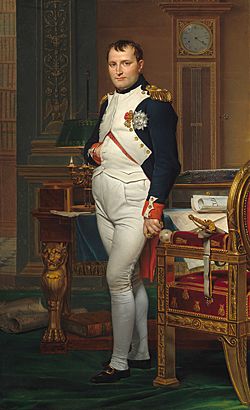The Emperor Napoleon in His Study at the Tuileries facts for kids
Quick facts for kids The Emperor Napoleon in His Study at the Tuileries |
|
|---|---|
 |
|
| Artist | Jacques-Louis David |
| Year | 1812 |
| Medium | Oil on canvas |
| Dimensions | 203.9 cm × 125.1 cm (80.3 in × 49.3 in) |
| Location | National Gallery of Art, Washington, D.C. |
The Emperor Napoleon in His Study at the Tuileries is a famous painting from 1812. It was created by the French artist Jacques-Louis David. The painting shows Napoleon I, who was the Emperor of France, in his office. He is wearing his military uniform.
This artwork was ordered by a Scottish nobleman named Alexander Hamilton, 10th Duke of Hamilton. He admired Napoleon very much. The painting was finished in 1812. It is now kept at the National Gallery of Art in Washington, D.C.
Contents
What the Painting Shows
This painting is tall and shows Napoleon standing. He is almost life-size. He wears the uniform of a colonel from the Imperial Guard. This uniform is blue with white and red parts. He also has his special awards, like the Legion of Honour.
Napoleon's right hand is tucked into his jacket. This was a common pose for portraits at the time.
Details in Napoleon's Study
The painting shows many details in Napoleon's office. On his desk, you can see a pen, books, and rolled papers. More papers and a map are on the green carpet. The artist's signature is on these papers.
The painting suggests Napoleon has been working all night. His cuffs are unbuttoned, and his hair looks a bit messy. The candles are flickering, and the clock shows 4:13 AM. All these details make it seem like he has been busy writing new laws. One of these laws was the Code Napoléon. The word "Code" is clearly visible on the papers.
This painting shows Napoleon as a hard-working leader. It focuses on his role in creating laws, not just his military victories. However, a sword on the chair reminds us of his success as a soldier. Symbols like the fleurs-de-lys and bees also show the strength of his empire.
How the Painting Was Made
Artists often change their work as they paint. Jacques-Louis David also made many changes to this painting. He wanted to make sure everything looked balanced. He also added hidden meanings.
Early Ideas for the Painting
When David first started, he painted two tall columns. These columns were on either side of Napoleon's body. They were very noticeable. David realized these columns might take attention away from Napoleon himself.
So, he changed them. The columns became a carved panel on the left. On the right, he painted a clock. The clock was first painted larger. Later, he made the clock face smaller and moved it up. This helped to hide the old column brush strokes.
These changes made the painting much better. Your eyes now focus more on Napoleon's face. You can see his expression clearly. The changes also allowed David to add more symbols, like the time on the clock.
Adding More Symbols
David also added more symbols to the table and the lower part of the painting. Many of these were painted over older designs. For example, the fleurs-de-lis symbols are not very common in the final painting.
See also
- List of paintings by Jacques-Louis David

